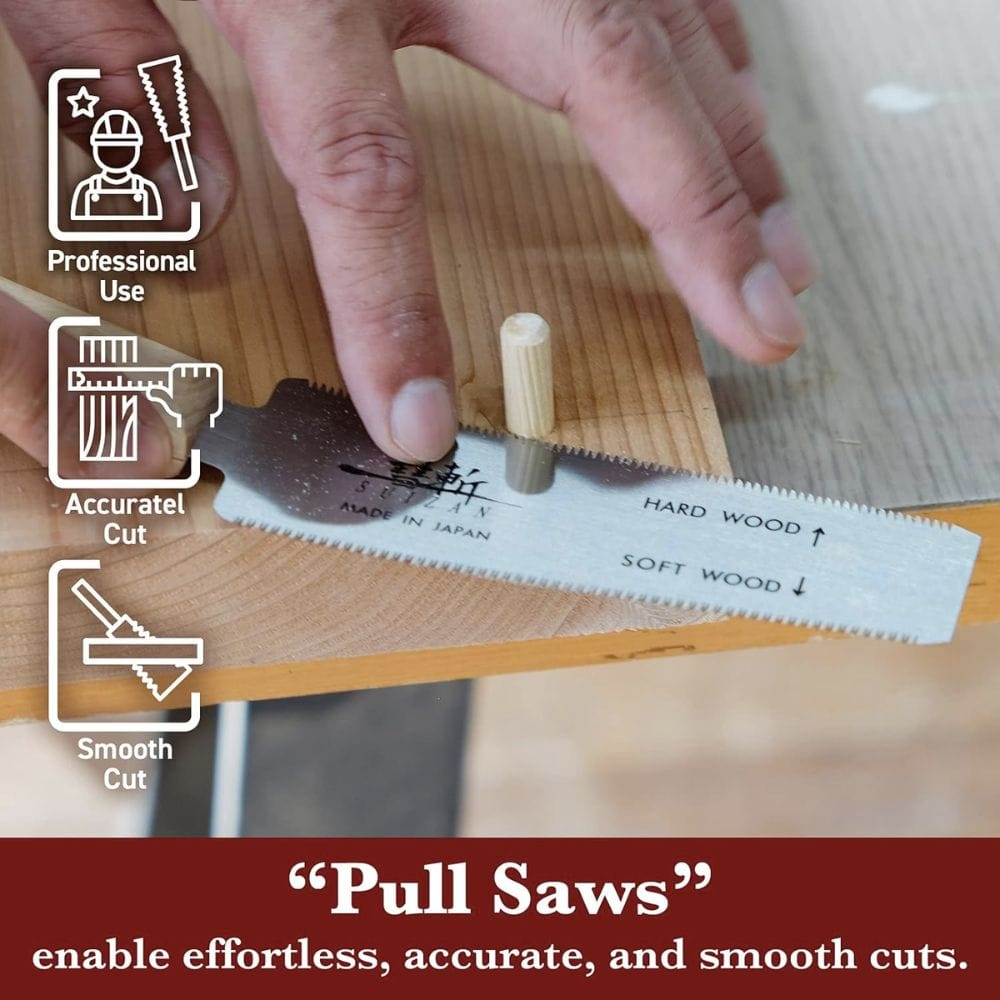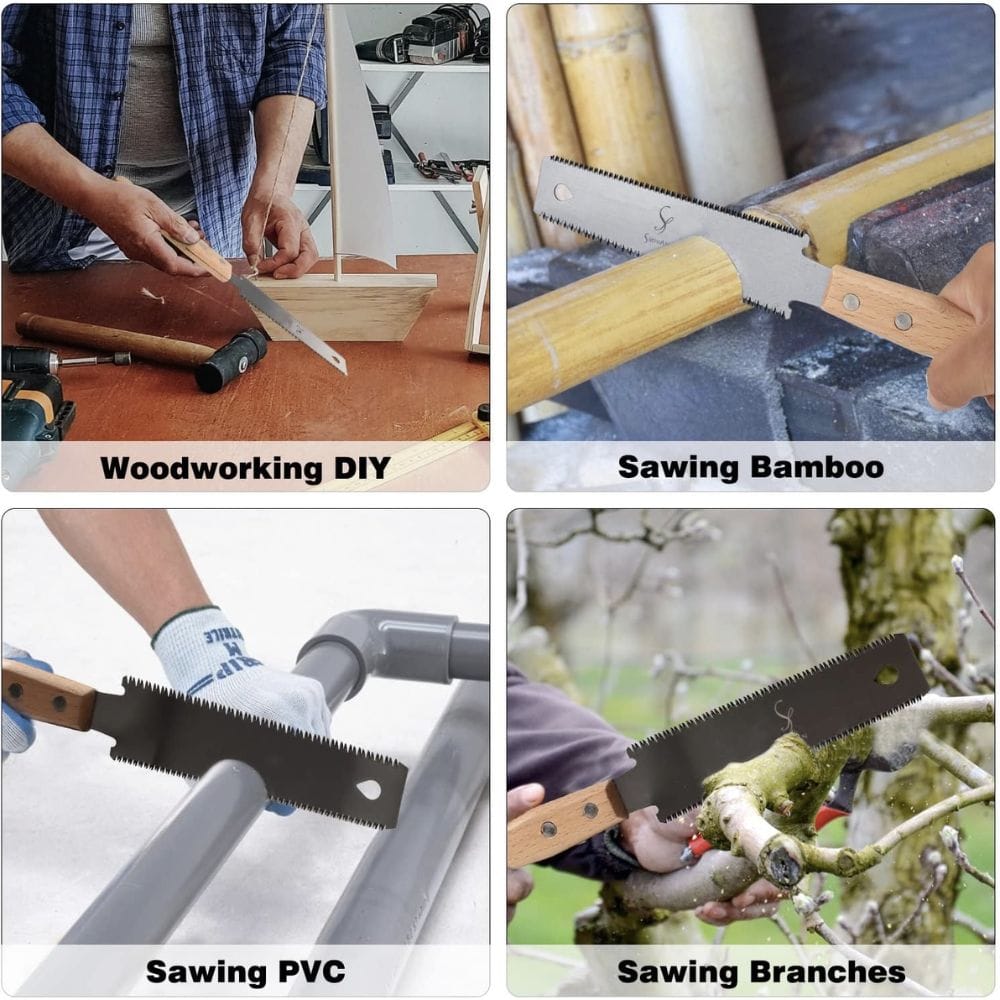Key Takeaways:
- Japanese pull saws offer precision and efficiency, making them ideal for woodworking enthusiasts and professionals alike.
- Understanding the different types of Japanese pull saws can help you choose the right tool for your specific needs.
- Proper maintenance and usage techniques can significantly extend the lifespan of your Japanese pull saw.
Introduction to Japanese Pull Hand Saws
Japanese pull hand saws, known as "nokogiri" in Japan, are revered for their precision and efficiency. Unlike Western saws that cut on the push stroke, Japanese saws cut on the pull stroke, allowing for finer, more controlled cuts. This unique design makes them a favorite among woodworkers who seek accuracy and ease of use.
The pull stroke mechanism reduces the risk of the blade bending, providing a cleaner cut with less effort. Whether you're a seasoned carpenter or a DIY enthusiast, understanding the nuances of these saws can elevate your woodworking projects to new heights.
Types of Japanese Pull Saws
Ryoba Saw
The Ryoba saw is a versatile tool with two cutting edges: one for rip cuts and the other for crosscuts. This dual functionality makes it a go-to saw for various woodworking tasks. The rip side is designed for cutting along the grain, while the crosscut side is perfect for cutting across the grain.
Ryoba saws are ideal for those who need a multi-purpose tool. They are particularly useful for tasks that require both types of cuts, such as making furniture or building structures. The flexibility of the Ryoba saw makes it a staple in any woodworker's toolkit.
Dozuki Saw
The Dozuki saw is known for its precision. It features a rigid back that supports the blade, allowing for extremely fine cuts. This saw is perfect for joinery and other tasks that require meticulous attention to detail. The thin blade and fine teeth make it ideal for cutting dovetails and tenons.
Dozuki saws are often used in cabinetry and other fine woodworking projects. The rigid back ensures that the blade remains straight, providing a high level of accuracy. If your projects demand precision, the Dozuki saw is an excellent choice.
Choosing the Right Japanese Pull Saw
Consider Your Project Needs
When selecting a Japanese pull saw, it's crucial to consider the specific requirements of your project. For general woodworking tasks, a Ryoba saw offers versatility with its dual edges. If your work involves intricate joinery, a Dozuki saw will provide the precision you need.
Understanding the nature of your project will help you make an informed decision. For instance, if you're building a piece of furniture that requires both rip and crosscuts, a Ryoba saw would be more suitable. On the other hand, for tasks that demand fine, detailed cuts, a Dozuki saw is the better option.
Blade Material and Quality
The quality of the blade is another critical factor to consider. High-carbon steel blades are known for their durability and sharpness. These blades maintain their edge longer, reducing the need for frequent sharpening. Additionally, look for blades that are rust-resistant to ensure longevity.
Investing in a high-quality blade can make a significant difference in your woodworking experience. A sharp, durable blade will provide cleaner cuts and require less maintenance. Always check the material and construction of the blade before making a purchase.
Proper Usage Techniques
Correct Grip and Posture
Using a Japanese pull saw effectively requires the right grip and posture. Hold the saw handle firmly but not too tightly, allowing for controlled movements. Your body should be positioned so that you can pull the saw towards you smoothly, using your shoulder and arm muscles.
Maintaining the correct posture will reduce fatigue and improve accuracy. Stand with your feet shoulder-width apart and keep your back straight. This stance provides stability and allows for more precise cuts. Practicing the correct technique will enhance your overall woodworking skills.
Cutting Techniques
When making a cut, start with a light pull to create a groove. This initial groove will guide the saw and prevent it from slipping. Once the groove is established, apply consistent pressure and pull the saw towards you in a smooth, controlled motion.
Avoid forcing the saw through the wood. Let the sharpness of the blade do the work. For rip cuts, use the rip side of a Ryoba saw, and for crosscuts, use the crosscut side. Following these techniques will result in cleaner, more accurate cuts.
Maintenance and Care
Cleaning and Storage
Proper maintenance is essential for extending the lifespan of your Japanese pull saw. After each use, clean the blade with a soft cloth to remove any sawdust or resin. Store the saw in a dry place to prevent rust and corrosion.
Regular cleaning and proper storage will keep your saw in optimal condition. Consider using a blade cover or case to protect the teeth from damage. Taking these simple steps will ensure that your saw remains sharp and ready for use.
Sharpening the Blade
Over time, even the best blades will require sharpening. Use a fine-toothed file to sharpen the teeth, following the original angle of the blade. Sharpening should be done carefully to maintain the blade's integrity and performance.
Regular sharpening will keep your saw cutting smoothly and efficiently. If you're not confident in your sharpening skills, consider taking the blade to a professional. Properly sharpened blades make a significant difference in the quality of your cuts.
Popular Brands and Models
Gyokucho
Gyokucho is a well-known brand that offers a range of high-quality Japanese pull saws. Their products are known for their durability and precision. The Gyokucho 372 is a popular model that features a replaceable blade, making it a cost-effective choice for long-term use.
Gyokucho saws are favored by both professionals and hobbyists. The brand's commitment to quality ensures that their saws provide excellent performance and longevity. If you're looking for a reliable saw, Gyokucho is a brand worth considering.
Suizan
Suizan is another reputable brand that produces top-notch Japanese pull saws. The Suizan Ryoba saw is particularly popular for its versatility and sharpness. Suizan saws are crafted using traditional Japanese techniques, ensuring high standards of quality.
Suizan's attention to detail and craftsmanship make their saws a favorite among woodworkers. The brand offers a variety of saws to suit different needs, from general woodworking to specialized tasks. Investing in a Suizan saw is a decision you won't regret.
Practical Examples and Case Studies
Furniture Making
Japanese pull saws are widely used in furniture making due to their precision and efficiency. For instance, a Ryoba saw can be used to make both rip and crosscuts when building a table. The fine teeth of a Dozuki saw are perfect for creating dovetail joints in drawers.
These saws allow for cleaner cuts, reducing the need for extensive sanding and finishing. Woodworkers often find that using Japanese pull saws speeds up their workflow while maintaining high standards of quality. The versatility and precision of these saws make them invaluable tools in furniture making.
Home Improvement Projects
Home improvement projects, such as building shelves or installing trim, can benefit greatly from the use of Japanese pull saws. The ability to make precise cuts ensures that pieces fit together perfectly, resulting in a professional-looking finish.
For example, a Dozuki saw can be used to cut intricate moldings, while a Ryoba saw is ideal for cutting larger pieces of wood. These saws provide the accuracy needed for detailed work, making them essential tools for any home improvement project.
Common Mistakes to Avoid
Using the Wrong Saw
One common mistake is using the wrong type of saw for a specific task. For example, using a Ryoba saw for fine joinery can result in less precise cuts. It's important to choose the right saw for the job to achieve the best results.
Understanding the strengths and limitations of each type of saw will help you avoid this mistake. Always match the saw to the task at hand to ensure clean, accurate cuts. This simple step can significantly improve the quality of your work.
Improper Maintenance
Neglecting maintenance can lead to a dull blade and poor performance. Failing to clean the saw after use or store it properly can result in rust and corrosion. Regular maintenance is crucial for keeping your saw in top condition.
Make it a habit to clean and store your saw correctly after each use. Regularly check the blade for sharpness and sharpen it as needed. Proper maintenance will extend the lifespan of your saw and ensure it performs at its best.
5 of the Top Japanese Pull Hand Saws Available on Amazon
We hope you find your next awesome thing from the list below! Each product was independently selected by our editors. Some may have been sent as samples for us to fiddle with, but all opinions in this article are our own. Oh, and FYI — AnnesAnalytics may collect a share of sales or other compensation from the links on this page if you decide to buy something (that's how we stay in business). Reviews have been edited for length and clarity. Enjoy finding your next awesome thing.
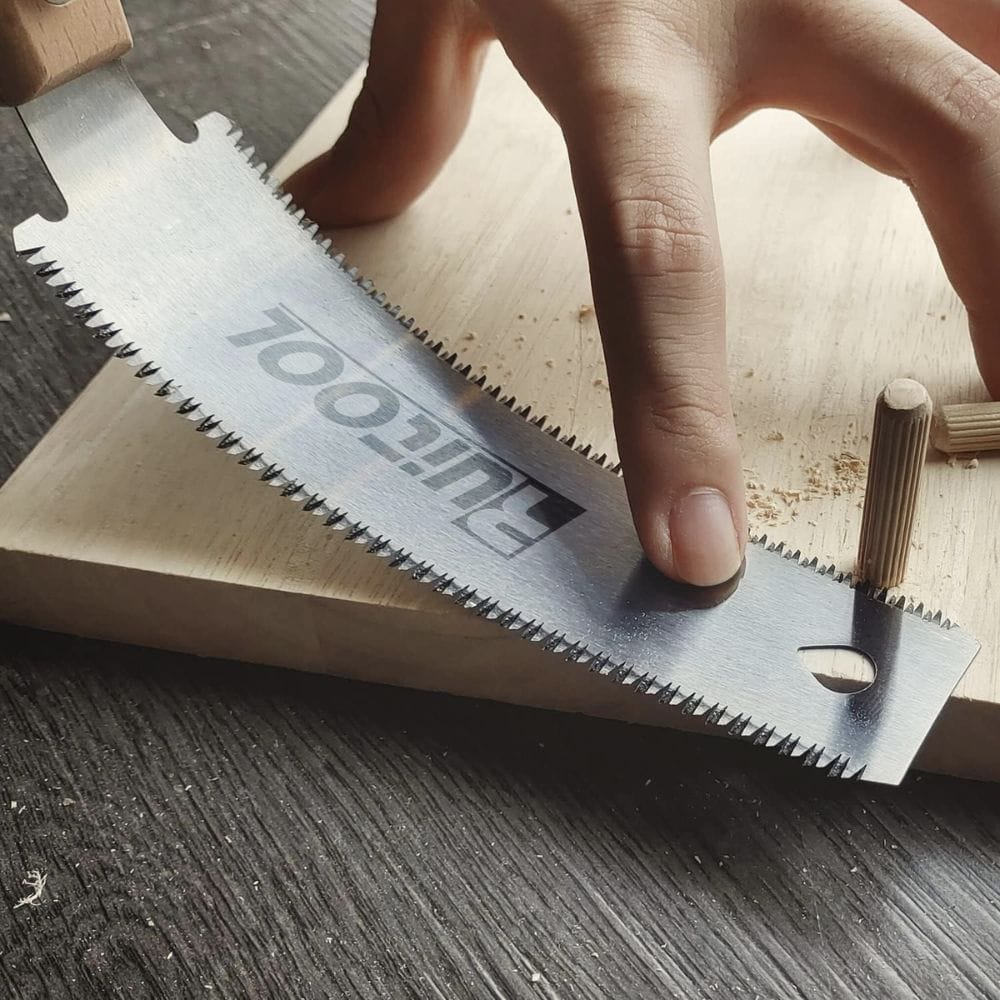
RUITOOL Japanese Hand Saw
6 Inch Double Edge Sided Pull Saw Ryoba SK5 Flexible Blade 14/17 TPI Flush Cut Beech Handle Wood Saw for Woodworking
Why We Love This
After extensive testing, we have determined that a 6" Japanese saw blade is the perfect size for precise cutting. This size allows for easy flush and finish cuts, making it an essential tool for any woodworker.
Durable & Flexible Saw Blade
Our hand saw blade is crafted from SK5 high-carbon steel, ensuring durability and flexibility. The teeth of the Japanese pull saw are processed using a high-frequency hardening machine imported from Japan, achieving a hardness of HRC60-63 degrees.
Double Edged for Versatility
This Japanese hand saw features a double-edged design: one side with 17 TPI (teeth per inch) for cutting hardwood and the other side with 14 TPI for cutting softwood. It can be used for both rip cuts and cross cuts, providing versatility for various woodworking projects.
Hardened 3-Edge Teeth
The hand saw is equipped with a three-sided grinding gear design, offering a sharp edge, faster chip removal, and smoother cutting. This design enhances efficiency and precision in your woodworking tasks.
Lifetime Guarantee
As a professional woodworking brand, Ruitool offers a lifetime after-sales guarantee and a 100% problem-solving service. Contact us anytime for assistance and enjoy peace of mind with your purchase.

Encouraging Review
"This little saw is amazing. Sharp, accurate yet flexible with the ability to cut soft and hardwood. Easy to use and really accurate. I haven't asked it to do a whole lot yet but cutting dowels off and making small cuts in small pieces has been a dream compared to American/ English saws that cut on the push rather than the pull." Amazon Review by Amanda Chillemi
Why We Love This
A Japanese Style Pull Saw is a unique type of saw known as a "Pull Saw." Unlike European saws, commonly referred to as "push saws," which cut through a pushing motion, Japanese hand saws cut materials via pulling. This design makes the Japanese pull saw lighter in weight, requiring less power and resulting in a cleaner edge.
Superior Japanese Steel
All SUIZAN Japanese saws are crafted from top-quality Japanese steel. This high-quality steel ensures razor-sharp cuts, enhancing your woodworking precision and efficiency.
Authentic Craftsmanship
Every SUIZAN woodworking tool is manufactured in Japan by master craftsmen. The entire production process takes place in a Japanese town renowned for its craft-making tradition, boasting a history of over 100 years. This heritage guarantees the authenticity and superior quality of each tool.
Versatile Blade for Hardwood and Softwood
This small hand saw is equipped with a robust blade suitable for cutting both hardwood and softwood. It effortlessly handles materials such as oak, sandalwood, ebony, mahogany, maple, walnut, and pine. For softwood, it is perfect for white cedar, Japanese cedar, larch, paulownia wood, and many others. Note that the blade is not replaceable.
Enhance Your Woodworking Experience
Whether you are a master craftsman or a beginner, using traditional Japanese-style saws offers a new and enriching experience. These saws allow you to create a wider range of woodworking products, diversifying and enhancing your woodworking life.

Encouraging Review
"If you’re cutting off dowels at all, this little guy is what you need. The saw is small so it fits into tight spaces, and the blade flexes allowing you to make effortlessly flush cuts. (That’s Important) This baby is well made and worth the price. No hassle delivery No Brainer! Buy this one!" Amazon Review by The WHITE ALBUM
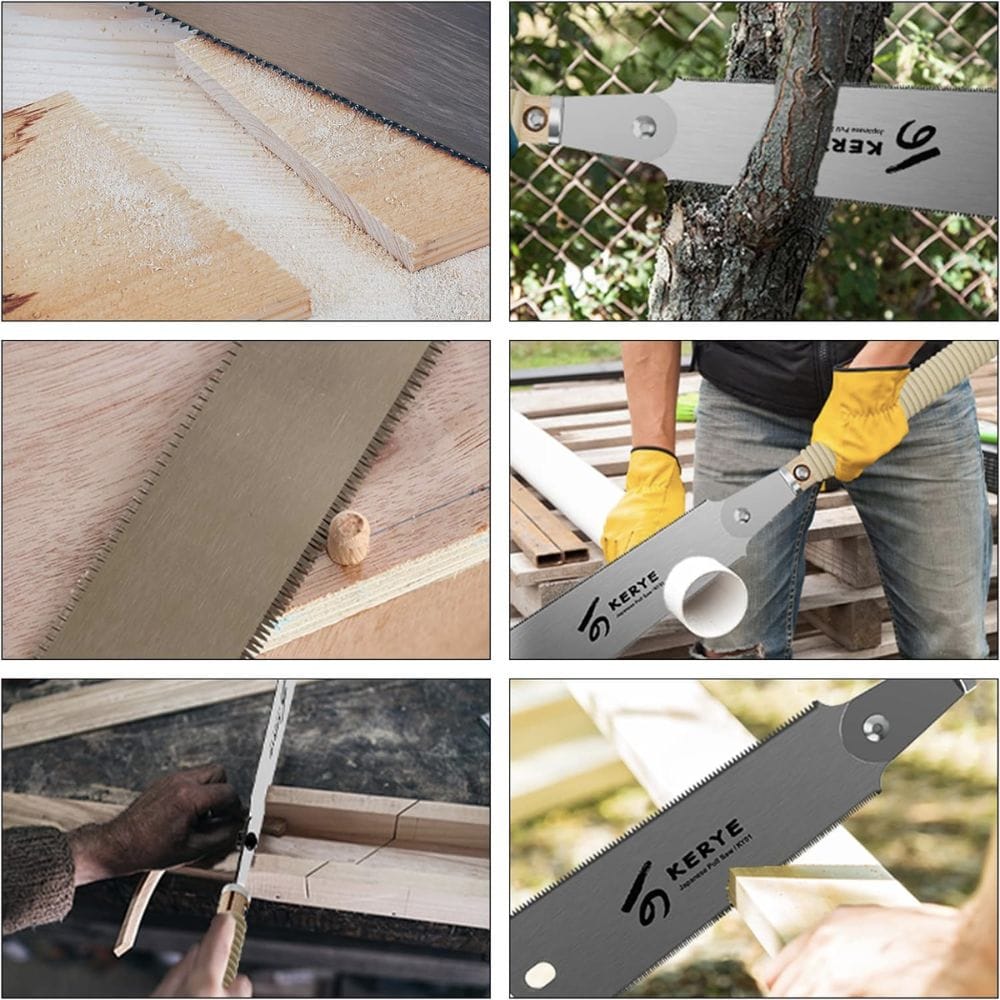
KERYE Japanese Pull Saw 9.5 Inch
Hand Saw with Double Edges of 10/17 TPI and Replaceable Blade
Why We Love This
Upgrade your toolkit with our 9.5-inch pull saw, offering a larger working area compared to a 6-inch saw. This increased size provides more working possibilities and saves at least 50% of the force required, thanks to the principles of physics.
Sturdy and Durable Material
Our saw blade is crafted from SK5 high carbon steel, renowned for its hardness and wear resistance. The handle is made from beech and rattan, ensuring it is lightweight and ergonomic, saving both time and effort during use.
3-Sided Grinding Teeth
Professionals know the value of a saw with 3-sided grinding teeth. This design makes the saw sharper, more wear-resistant, and extends its lifespan. Additionally, the denser side teeth are quenched for extra hardness.
2-in-1 Pull Saw
This versatile bi-lateral saw features two sides with different teeth configurations. One side has 10 TPI (teeth per inch) for rougher, quicker cuts, while the other side has 17 TPI for denser, more detailed cuts. The rougher side is ideal for rip cuts, and the denser side is perfect for cross cuts.
Reliable After-Sale Support
We offer 24 months of after-sale support and a 100% problem-solving service to ensure your satisfaction.

Encouraging Review
"Bought this saw to cut off white ash pegs...it was perfect. Nice and sharp, didn't mar the surrounding wood and much better than the back saw I usually use. Inexpensive, well worth the price and I will be going to this saw a lot in the future!" Amazon Review by Diego
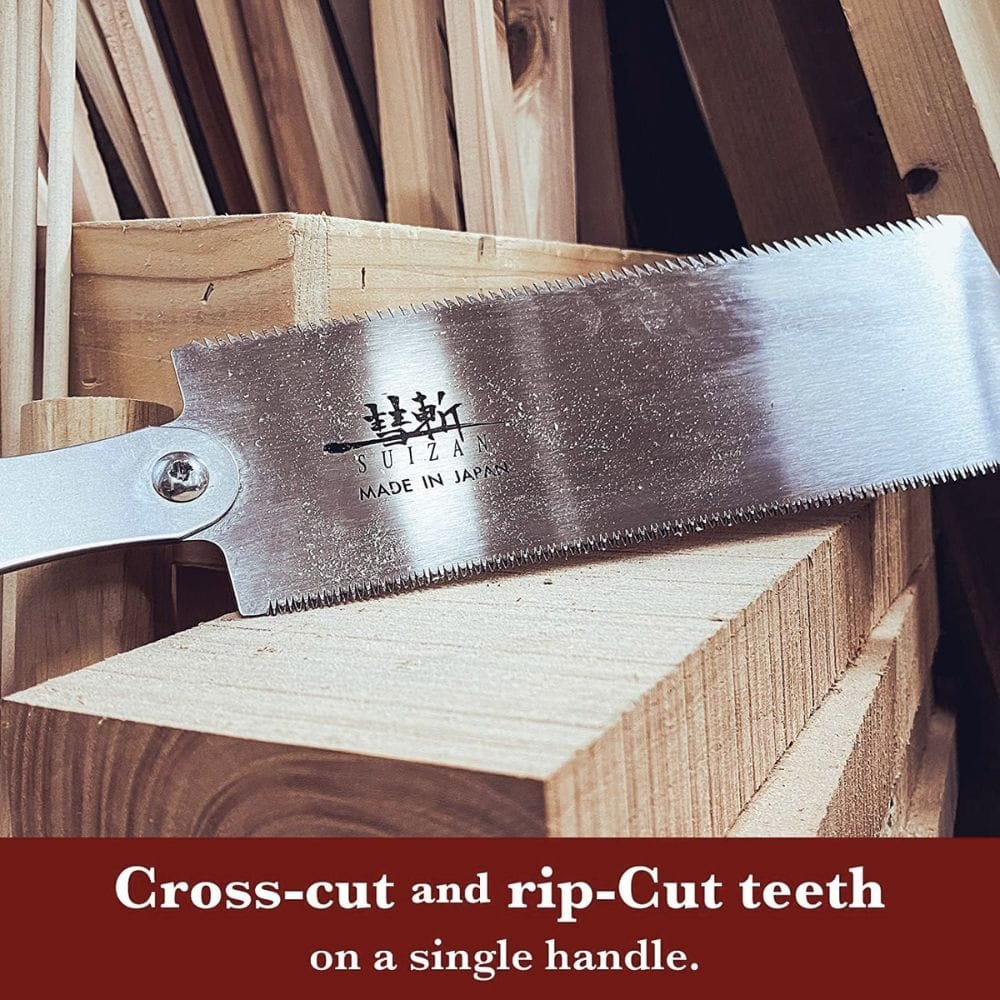
SUIZAN Japanese Pull Saw
9.5 Inch Ryoba Double Edge Flush Cut Saw for Woodworking
Why We Love This
Discover the superior craftsmanship of the Japanese Style Pull Saw. Unlike traditional European saws, known as "push saws" that cut through a pushing motion, Japanese saws operate via pulling. This unique design makes the Japanese pull saw lighter, requiring less effort and delivering a cleaner edge.
Japanese Steel
All SUIZAN Japanese saws are crafted from premium Japanese steel, renowned for its exceptional quality. This high-grade steel ensures razor-sharp cuts, enhancing your woodworking precision.
Made in Japan
Every SUIZAN woodworking tool is meticulously manufactured in Japan by master craftsmen. The entire production process takes place in a town with a rich history of over 100 years in craft-making tradition, ensuring each tool embodies the pinnacle of Japanese craftsmanship.
Diversify Your Woodworking Life
Whether you are a seasoned woodworker or a beginner, incorporating traditional Japanese-style saws into your toolkit offers a transformative experience. These saws enable you to create a broader range of woodworking projects, enriching your craft and diversifying your skills.
Product Specifications
- For Rip & Cross Cut
- Blade Length: 9.5" (240mm)
- Blade Thickness: 0.02" (0.5mm)
- TPI: 9 & 15 (1.67mm)
- Kerf Width: 0.03" (0.8mm)
- Overall Length: 23.2" (59cm)
Each handle is individually wrapped by hand by skilled craftspeople, resulting in unique appearances. Note that minor cracks may occur during the manufacturing process, which are not defects but a testament to the handcrafted nature of these tools.

Encouraging Review
"This is a fantastic saw. The cross cut edge leaves a very fine finish and cuts very fast. The rip edge cuts very fast and also leaves a smooth-ish edge. The rip edge has not been hardened so it could be resharpened if desired. This saw replaces two saws and therefore is a big money and space saver." Amazon Review by Robert Hull
Why We Love This
Our Japanese hand saw features a sawtooth processed by a high-frequency quenching machine imported from Japan, achieving a hardness of HRC60-63 degrees. This ensures more precise cuts compared to typical Western saws.
Superior Blade and Handle
The SK5 high carbon steel saw blade guarantees extremely fine cut surfaces with minimal effort. The handle, made of beech wood, is lightweight, ergonomically designed, and offers a soft touch for easy use and a neat finish.
2-in-1 Pull Saw
This double-sided Japanese saw has two sets of teeth: one side with 11 TPI (teeth per inch) for rougher, quicker longitudinal cuts, and the other side with 17 TPI for denser, more detailed cross cuts. Ideal for tasks like flush cuts with the wall in wood.
Smoother Cutting
Equipped with 3-sided grinding teeth, this saw is sharper and more wear-resistant. Cutting on the pull stroke reduces binding, making it easier to achieve smoother cuts. It outperforms large hand saws for fine work.
Ideal Choice for Woodworking and DIY Projects
Whether you're a professional or a beginner, this Japanese-style saw is a valuable addition to your tool arsenal. It can be used for various purposes, including pruning, woodworking, handicraft work, gardening, and cutting PVC & ABS plastic pipes. Suitable for both dry and wet wood.

Encouraging Review
"Bought this specifically for cutting off Dowel inserts.
it cuts them like butter. Don't know about the longevity yet, but it looks like it will last." Amazon Review by G-man
Summary
Japanese pull hand saws are exceptional tools that offer precision, efficiency, and versatility. Understanding the different types of saws, such as the Ryoba and Dozuki, can help you choose the right tool for your woodworking projects. Proper usage techniques and maintenance are essential for getting the most out of your saw. Brands like Gyokucho and Suizan offer high-quality options that cater to various needs. Whether you're making furniture or tackling home improvement projects, a Japanese pull saw can elevate your work to new levels of craftsmanship.
FAQ
What is the main advantage of a Japanese pull saw?
The main advantage of a Japanese pull saw is its ability to make precise, clean cuts with less effort. The pull stroke mechanism reduces the risk of the blade bending, providing more control and accuracy.
How do I choose the right Japanese pull saw for my project?
Consider the specific requirements of your project. For general woodworking tasks, a Ryoba saw offers versatility. For intricate joinery, a Dozuki saw provides the precision needed. Assess the nature of your work to make an informed decision.
How often should I sharpen my Japanese pull saw?
The frequency of sharpening depends on how often you use the saw and the type of wood you cut. Regularly check the blade for sharpness and sharpen it as needed. Proper maintenance will ensure optimal performance and longevity.


